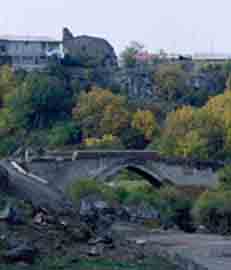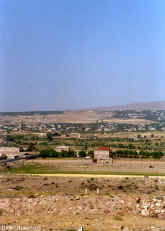|

|
Ashtarak
(“Tower”)
is the administrative capital of
Aragatsotn, spread out in
and above the gorge of the Kasakh river.
The city is endowed with old churches, interesting
museums, and
some ambitious restaurant/hotel/casino complexes
suitable for lengthy
carouses.
From the highway,
a left exit before the massive half-finished |
|
Oshakan, is
most famous as the last resting place of Mesrop
Mashtots,
(d. 442) founder of the Armenian alphabet. Above his grave (19th c.
gravestone) is a church
rebuilt by Katholikos George IV in 1875. It has
wall-paintings from 1960 by the artist H. Minasian. Excavations on
Didikond hill, which
rises just behind (S) of
Oshakan,
revealed a square fort of
the
|

|
|
bridge winds down into
Ashtarak, crossing via the lower bridge downstream. Turning right and continuing about 1 km, turn right again
just after the main square to reach the Tsiranavor,
Spitakavor, and
Karmravor S. Astvatsatsin churches, the House Museum of the novelist
Perch Proshian, and a view of the old bridge of 1664. S. Mariane church of 1281 is further W.
It is marred by an unfinished early 20th c. basilica
tacked on. On the right
bank of the gorge above the medieval bridge is the new church of S. Sargis on early foundations. The area has various
interesting monuments (old bath,
urartian through medieval irrigation
canal, fort
remains, medieval meal,
beatiful
houses from the end of 19th c.). Ashtarak
is also rich with beautiful khachkars
mainly located in the cemeteries of the city. Just after the new
brigde, on the right side of the main Guymri Highway, bypassing
the city, on the left section of the Kasakh river gorge are
scant remains of Bronze
Age through medieval period settlement (the place is
called by locals Darabavor), inhabited mostly in the Middle
Bronze age. Down the gorge are the famous Darabavor
caves used for refuge in the medieval times.
|
|
7-5th c. BC, with five palace
complexes on the N slope. Just
N of Oshakan, in a little valley called Mankanots, is a 7th
c. S. Sion church, with beside it an
unusual pillar on a plinth dated to
the 6-7th c. and traditionally believed to mark the grave of
the Byzantine emperor Mauricius or his mother, based on the fact that
one Armenian historian says he came from here. Elsewhere in the
vicinity are shrines of
S. Grigor,
S.
Sargis, S.
Tadevos the Apostle, a rock-cut
Astvatsatsin, and a Tukh
Manuk shrine
atop the hill. The area has a series of rich
Bronze and Iron Age tomb fields (Middle Bronze Age huge tombs
of Nor Oshakan are situated SE).
W of Oshakan is a bridge of 1706 over the
Kasakh river.
|